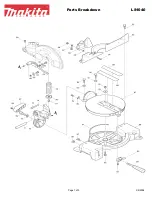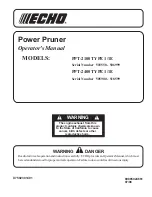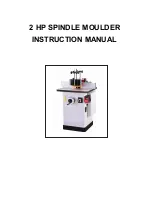
2
Palmgren Operating Manual & Parts List 9683127
GETTING STARTED
STRUCTURAL REQUIREMENTS
Make sure all supporting structures and load attaching devices are
strong enough to hold your intended loads. If in doubt, consult a
qualified structural engineer.
ELECTRICAL REQUIREMENTS
The power supply to the Band Saw needs to be 120 volt/ 3.5 amp,
single phase, 60 Hz. The standard allowable voltage variation is plus
or minus 10%.
TOOLS NEEDED:
Standard mechanic’s hand tool set.
UNPACKING
WARNING:
Be careful not to touch overhead power lines, piping,
lighting, etc. if lifting equipment is used. Band Saw weighs
approximately 77 lbs, proper tools, equipment and qualified personnel
should be employed in all phases of unpacking and installation.
Carton should be handled with care to avoid damage from
dropping, bumping, etc. Store and unpack carton with correct side
up. After unpacking Band Saw, inspect carefully for any damage that
may have occurred during transit. Check for loose, missing or
damaged parts. If any damage or loss has occurred, claim must be
filed with carrier immediately. Check for completeness. Immediately
report missing parts to dealer.
Band Saw is shipped partially assembled. End user will need to
assemble loose parts to machine.
IMPORTANT:
The tool has been coated with a protective coating. In
order to ensure proper fit and operation, the coating must be
removed. Remove coating with mild solvents such as mineral spirits
and a soft cloth. Nonflammable solvents are recommended. After
cleaning, cover all exposed metal surfaces with a light coating of
oil.Paste wax is recommended for table top.
CAUTION:
Never use highly volatile solvents. Avoid getting cleaning
solution on paint as it may tend to deteriorate these finishes. Use soap
and water on painted components.
CONTENTS:
• Band Saw (1)
• Table (1)
• Guide rail (1)
• Rip fence with knob (1)
• Miter gauge assembly (1)
• Pushstick (1)
• Hardware bag (1) - Includes: M6 x 30 hex head bolt and nut; four
each hex bolts and M6 serrated washers; four each wing nut
bolts and washers.
• Operating Instructions and Parts Manual (1)
UNPACK:
Do not discard packing materials until after machine has been
inspected for damage and completeness. Locate loose parts and set
aside.
INSPECT:
After unpacking the unit, carefully inspect for any damage that may
have occurred during transit. Check for loose, missing or damaged
parts. Shipping damage claims must be filed with the carrier.
All tools should be visually inspected before use, in addition to
regular periodic maintenance inspections.
Be sure that the voltage labeled on the unit matches your power
supply.
SAFETY RULES
WARNING:
For your own safety, read operating instructions manual
before operating tool.
PROPOSITION 65 WARNING:
Some dust created by using power tools
contain chemicals known to the state of California to cause cancer,
birth defects or other reproductive harm.
Some examples of these chemicals are:
• Lead from lead-based paints
• Crystalline silica from bricks and cement and other masonry
products.
• Arsenic and chromium from chemically treated lumber.
Your risk from these exposures varies, depending on how often you
do this type of work. To reduce your exposure to these chemicals;
work in a well ventilated area and work with approved safety
equipment. Always wear
OSHA/NIOSH
approved, properly fitting
face mask or respirator when using such tools.
WARNING:
Always follow proper operating procedures as defined in
this manual even if you are familiar with the use of this or similar tools.
Remember that being careless for even a fraction of a second can
result in severe personal injury.
BE PREPARED FOR JOB
• Wear proper apparel. Do not wear loose clothing, gloves,
neckties, rings, bracelets or other jewelry which may get caught
in moving parts of machine.
• Wear protective hair covering to contain long hair.
• Wear safety shoes with non-slip soles.
• Wear safety glasses complying with United States ANSI Z87.1.
Everyday glasses have only impact resistant lenses. They are
NOT
safety glasses.
• Wear face mask or dust mask if operation is dusty.
• Be alert and think clearly. Never operate power tools when tired,
intoxicated or when taking medications that cause drowsiness.
PREPARE WORK AREA FOR JOB
• Keep work area clean. Cluttered work areas invite accidents.
• Do not use power tools in dangerous environments. Do not use
power tools in damp or wet locations. Do not expose power
tools to rain.
• Work area should be properly lighted.
• Proper electrical receptacle should be available for tool. Three-
prong plug should be plugged directly into properly grounded,
three-prong receptacle.
• Extension cords should have a grounding prong and the three
wires of the extension cord should be of the correct gauge.
• Keep visitors at a safe distance from work area.
• Keep children out of workplace. Make workshop childproof. Use
padlocks, master switches or remove switch keys to prevent any
unintentional use of power tools.


































